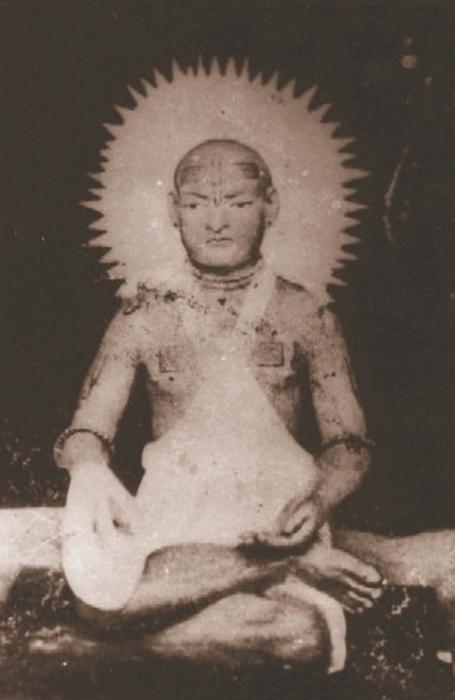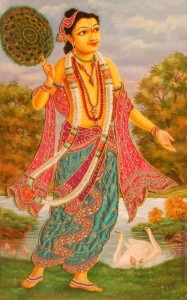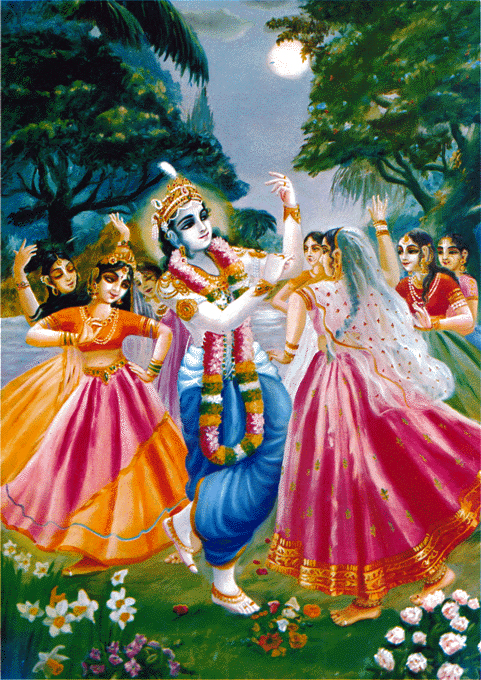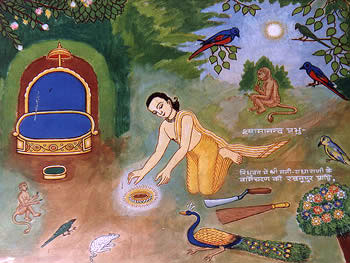In this month the sun moves into Mesha rasi (Aries), and the new year begins according to many calanders.
Keshava Vrata starts; for one month one should control the senses, sleep on the earth, bath twice daily in a river, worship the Lord and give cloth, sugar, sesame, rice, and gold to the brahmanas. If one worships Madhsudana in this month one gains the benefits of one years worship.
While Keshava Vrata lasts one may hang a pot with a hole in it, fill it with water and drip water over Tulasi and a Shalagrama Shila.
This is especially done in the now hot northern hemisphere when water becomes a vital asset for the growth of Tulasi Devi. In the southern hemisphere be careful not to overwater as we come out of Summer and into Autumn.
All Posts (4030)
On this day the Ganga is worshipped and many people make offerings to the forefathers, and bathe in the Ganga. On this day, if possible, one should worship the Ganges and bathe in her waters.
From Bhaktivinode Thakura's Sri Navadvipa Mahatmya Chapter 13: Description of Vidyanagara and Jahnudvipa
As Nityananda spoke, they went to Jannagara where they saw the enchanting hermitage of Jahnu Muni. Nityananda Prahhu explained, "This enchanting place named Jahnudvipa is known as Bhadravana. At this place, Jahnu Muni underwent penances and received darsana of the golden form of Gauranga.
"Jahnu Muni was sitting here chanting his gayatri mantra, when his acamana cup fell into the Bhagirathi (Ganges) and was swept away by the currents. He opened his mouth and drank all the water in one gulp. King Bhagiratha thought, 'Where has the Ganges gone?' He concluded that Jahnu Muni had drunk theGanges. The king was overwhelmed with anxiety and worshipped the muni for several days. The muni then released the
9 hrs
নিত্যানন্দী দাসী
নিত্যানন্দী দাসী Manjari bhava for sadhakas is the aspiration to serve Srimati Radharani under the maidservants of Her sakhis...for us it is ultimately under Rupa manjari (Rupa Goswami) but one will directly serve the servant of Her servant of Her servant.
Nitai kripa is easily available in 5 ways. One is to always serve Sri Guru who is the direct representative of Nityananda Rama. Secondly, one should call upon the mercy of Lord Sadashiv who is the guardian of Nitai's home, Ekachakra dham. It is clear one can only attain Nitai and His kripa by Sadashiv's mercy. He is best approached as Adwaita acharya. Tava kripa bole pay Chaitanya Nitai.
The next is to take shelter of Jahnava mata. When Nitai hears Jahnava devi's Name once He must come running to give His kripa.
Worshipping Gauranga is the next way to get Nitai's mercy. Exalted acharyas like Vrindavan Das Thakur have written in Chaitanya Bhagavat that it is only by Gaura's mercy that one can achieve Nitai's fav
Brajanath Das's post.

Tridandisvami Sri Srimad Bhaktivedanta Narayana Gosvami Maharaja :
WE CANNOT CHANGE OURSELVES
Similarly, we cannot live without jnana (knowing anything). We will have to make all our jnana 'tattva-jnana;' or 'bhakti-jnana;' or better yet, 'bhakti-tattva-jnana;' or best, 'prema-tattva-jnana' – then it will not cover our bhakti. Otherwise, without understanding these principles, we will not be able to achieve bhakti at any time. Since we cannot live without jnana and karma, how shall we engage in these things? We will have to think about these things and always associate with any qualified Vaisnava. He can change us; we cannot change ourselves.
Everyone is going towards Krsna. How are they going? Some have faith in objects of material nature, like a mountain, river, or any ghost. What are these objects? They are the vibhuti (material opulence) of Krsna, so somehow they are connected with Him. In this world nothing is separate from Krsna, bu
Bhaja Govindam
by Sri Shankaracharya
Adi Shankaracharya is widely known for his teachings on Vedanta. Shankaracharya was born in the village of Kaladi, in South India, about 2500 years ago to his Brahmin parents, Sivaguru and Aryamba. He traveled throughout India during his life, preaching and establishing four important maths, or centers, and accepted numerous disciples. He had also composed a number of verses and hymns of his knowledge and insight. However, the Bhaja Govindam is perhaps his greatest. He is still today one of the greatest influences in the present-day understanding of Vedic philosophy, with numerous schools of thought throughout India still expounding his teachings.
He primarily taught the non-dual, or advaita, form of understanding, teaching that everything is ultimately one. Many of the commentaries on the Vedic texts, such as the Brahma-samhita, the Upanishads, and others, are written with commentaries by those who follow his advaitic principles. Th
Candana Yatra is a festival during the hot season in India in which the Deities are covered with sandalwood paste (candana) to cool Them. (This is generally impractical in the West, where it is cold during this time.)
For 21 days with the Utsava Vigrahas covered in chandan. The Deities are covered completely with chandan(sandalwood paste), which provides the Lord relief from the scorching heat of summer in the month of Vaisakha/Jyestha (May/June).
Once, Lord Jagannatha instructed the ancient King Indradyumna to perform this festival on this occasion. Smearing the body of the Lord with ointments is an act of devotion, and the best of balms is said to be sandalwood paste. Since heat in the month of Vaisakha is extreme in India, the cooling effect of sandalwood paste would be pleasing to the Lord.
Sandalwood paste is applied all over the body of Lord Jagannatha leaving only his two eyes exposed. The Utsava Vigrahas (functional Deities – Vijay Utsav) are taken on procession and placed in a bo
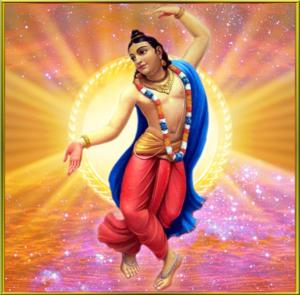
Sri Gadadhara Pandit. He was a member of the Panca Tattva and is described as the effulgence of Srimate Radharani.
Sri Gaurahari had so much affection for Sri Gadadhara Pandit that He couldn't be without him for a moment. He appeared a year after Lord Caitanya. Gadai and Nimai were inseparable as childhood playmates. Peaceful, renounced, serious, self-composed, fond of solitude Gadadhara proved quite a contrast to his bosom friend Gaura Raya, who was fickle, unsteady, and whimsical. In Ganga Dasa Pandit's tol (school) Nimai Pandit regularly teased Gadadhara by challenging him with illogical questions.
Sri Kavi Karnapura states that in Vraja lila Gadadhara Pandit is the daughter of King Vrsabhanu–Srimati Radharani. Gadadhara Pandit served as Lord Gaura's chief assistant during His Navadvipa-lila. Sri-Sri Radha Krishna in Vrindavana appear as Gaura-Gadadhara to perform pastimes in Navadvipa in the forest groves beside the Ganges.
Gadadhara Pandit"No one call describe the characte
In her childhood, Narayani Devi, neice of Srivasa Pandit, became mad with love of God upon receiving the mercy of Sri Gauranga Mahaprabhu. Later she gave birth to Vrindavana Dasa, who was the last disciple of Sri Nityananda Prabhu. On his guru's order he wrote Sri Caitanya Bhagavata.
It is practically a law among Vaisnava writers like Sri Rupa Goswami, Sri Sanatana Goswami, Krishna Dasa Kaviraja, and Vrindavana Dasa Thakura to always keep themselves in the background. They never mention anything about their family lineage or personal history. The authors of the best written and most relishable verses collected in Sri Rupa Goswami's Padyavali remain unknown.
During the sixteenth century, entire books of exceptional transcendental prose and poetry were penned by prideless Vaisnavas preferring to remain anonymous. Feeling utmost humility, such Vaisnava writers express themselves only in relation to their preceptors. Krishna Dasa Kaviraja glorifies his gurus at the end of each chapter of S
"You must have heard about the Indian scripture named Gita, which has been translated into different languages in the civilized world. There is a sloka in it which says that the Vaishnava philosophy is understandable only with unconditional surrender, honest enquiry and serving temper. It is only to such an approach (that) the professors of Vaishnava philosophy, with these three as the preceptorial fee, may give instructions about the correct philosophical truths. These professors are never to be tempted by any type of worldly fees."
Srila Bhaktisiddhanta Saraswati Thakur to Professor Suthers
According to Gaura-Ganodesha-Dipika (12) in Krishna-lila he was Shridama, one of the 12 prominent boy cowherd friends of Shri Krishna.
Shri Abhirama Gopal Thakura was also known as Shri Rama Das. He was a great Devotee of Lord Nityananda. On the order of Shri Nityananda Prabhu, he became a great acharya and preacher of Gaudiya Vaishnavism. He was a very influential personality, and atheists and blasphemers were very much afraid of him. Empowered by Shri Nityananda Prabhu, he was always in ecstasy and was kind to all fallen souls. It is siad that if he offered obeisances to any stone other than a shalagram-shila, it would immediately burst into pieces. According to Gaura-Ganodesha-Dipika (12) in Krishna-lila he was Shridama, one of the 12 prominent boy cowherd friends of Shri Krishna. He was Nityananda's dearmost Devotee. Abhiram Gopal's wife's name was Shri Malini devi.
Ines Naradić;
"Nama alone is complete suspension of the fleeting mental operations."
Bhaktisiddhanta Saraswati Prabhupada Thakur
Hanuman - the Personification of Servitorship
| Hanuman Deity in a flying pose, at Neem Karoli Baba temple in Taos (New Mexico) | |
HDG A.C. Bhaktivedanta Swami Srila Prabhupada
"Yes, the nine devotional process and how, by each process, one becomes perfect, just like Pariksit Maharaja, simply hearing, and Sukadeva Gosvami, simply chanting, reciting Bhagavatam. So both of them got salvation. Laksmi, she is simply pada-sevanam, giving massage to the lotus feet of the Lord. Arjuna simply made friendship with Krsna. Hanuman simply worked as a hard servant. He doesn't know what He is... "Lord Ramacandra wants it." Then it is done. Jump over. He does not know any philosophy. He has got bodily strength, so whatever Ramacandra says, he'll do. He was asked to bring that medicine for Laksmana. He did not know where to find it. "Take this whole mountain." (laughter) He was not intelligent. "Fight! We have to fight with Ravana. Then block his whole city by throwing stones and trees and dirt." Everything b
Lord Krishna’s springtime rasa dance. The purnima or full moon of Damodara month is the second full moon of the autumn season, and rasa lila is again celebrated.
This second rasa yatra is celebrated more in Bengal, whereas the first one is celebrated more in Vrndavana. On this day one should perform full worship of Radha and Krsna with many flowers, and place them in a rasa mandapa surrounded by the gopis. Sri Krishna Vasant Rasa is similar excepting that it is in the Spring (Vasant), at this time everyone dresses in yellow. On this full moon night the devotees usually leave out pots of sweet rice payasam for the Lord to enjoy during His rasas.
- See more at: http://harekrishnacalendar.com/vaishnava-calendar/sri-krishna-vasanta-rasa-2016/#sthash.DH44NHui.dpuf
By Deena Bandhu Das
From 5th Chapter of Bhakti-ratnakara
Balarama, the son of Rohini performed his rasalila in Ramaghat. This place is situated quite a long distance from where Krishna had his rasalila.
Balarama was the second body of Krishna himself and the depth of his real self was like the depth of a million oceans. He came to Vraja from Dvaraka and stayed during the two months of Chaita and Vaishakh to console Sri Nanda, Yasoda and the others. He pleased his sakhas in various ways. There also Balarama gave solace to all the Krishna priyas and charmed his own dear and loving gopis by having lilas with them. At that time Krishna killed Sankhachuda. Then Krishna and Balarama both performed divine lilas with their own lovers and played Holi. Only a learned devotee can describe the beauty of these celestial activities. In Sri Krishna Caitanya Carita Murari Gupta says; “Look at Rama and Krishna who are covered with jewels and suitably dressed for spring time. In a humorous mood they perfor
Feeling very sad (dukhi) over losing several children before his birth, his parents named him Dukhi Krishna Dasa. Upon taking diksha from Hrdaya Chaitanya he became known as Krishna Dasa. In Vrindavana, he joined Narottama Dasa Thakura and Shrinivasa Acharya to study the Goswami granthas under Shri Jiva Goswami.
Many "ankle bell stories" describe how Krishna Dasa received Radharani's mercy, the name Shyamananda, and his unique tilaka mark. Shripad B.V. Narayana Maharaja gives this account in Navadwipa Dhama Parikrama:
"While living in Vrindavana, Krishna Dasa regularly swept the streets before dawn. He performed this humble service so that the Vaishnavas would not hurt their feet while walking to the Temples. One morning he found a captivatingly beautiful golden ankle bracelet. When Lalita and Vishakha-sakhis asked for the bracelet Krishna Dasa said he would only give it to the original owner.
"Blindfolding Krishna Dasa, the gopis brought him to Shrimati Radhika. She allowed
When Vamsivadananda Thakura (Vamsi Dasa, Vamsivadana Thakura) appeared Lord Caitanya and Sri Advaita Prabhu were staying in his home. After the disappearance of Srimati Vishnu Priya Devi, Vamsi Dasa moved Her Mahaprabhu Deity to Koladvipa (present day city of Navadvipa). He began worshiping Him along with Pranavallabha, a Deity of Krishna. Vamsivadana wrote wonderful poems and songs expressing the philosophy of Gaudiya Vaisnavism. He was also the incarnation of Lord Murlimanohara's flute (vamsi). So it's not surprising that Vamsivadana Thakura's works contain sweet mellow expressions of devotion. - See more at: http://gaudiyahistory.iskcondesiretree.com/sri-vamsivadananda-thakura/#sthash.fqdxjHon.dpuf

One’s devotional service is spoiled when he becomes too entangled in the following six activities: (1) eating more than necessary or collecting more funds than required; (2) over-endeavoring for mundane things that are very difficult to obtain; (3) talking unnecessarily about mundane subject matters; (4) practicing the scriptural rules and regulations only for the sake of following them and not for the sake of spiritual advancement, or rejecting the rules and regulations of the scriptures and working independently or whimsically; (5) associating with worldly-minded persons who are not interested in Kṛṣṇa consciousness; and (6) being greedy for mundane achievements.
There are six principles favorable to the execution of pure devotional service: (1) being enthusiastic, (2) endeavoring with confidence, (3) being patient, (4) acting according to regulative principles [such as śravaṇaṁ kīrtanaṁ viṣṇoḥ smaraṇam – hearing, chanting and remembering Kṛṣṇ
Damanaka Chori or Dayanalagi
The following days the following is observed in Jagannath Puri.
This festival is celebrated on the thirteenth and fourteenth days of the bright fortnight of Chaitra (April). Deities of Lord Rama and Lord Krishna are taken in procession to the Jagannath Ballava Math. There the Deities get Their Dayana leaves from the garden at the math. On the fourteenth, the leaves are offered to Lord Jagannath, Lady Subhadra and Lord Balarama.
"Damanaka is a particular type of flowering tree, Artemisia indica. In modern Oriya it is called da-aNA. It is one of the two favorite flowers of Lord Jagannath, the other being campaka. It is said that Lord Jagannath comes to the Jagannath Vallabh garden in Puri to steal these flowers. Aropana means to plant. On this dvAdazI there is a ritual planting of the da-aNA tree."
Bhagavān has not, however, employed Māyā just to inflict miseries on the jīvas. She does that, but as mentioned earlier, her real purpose is to chasten the jīvas, to encourage them to turn to Bhagavān. The punishment she metes out serves three purposes: to administer reactions to the living beings for their unwholesome deeds, to deter them from further transgressions, and to impel them to seek a solution to this world of suffering. Since this punishment ultimately benefits the jīvas by uniting them with God, He generally does not choose to come between the jīva and Māyā.
So, misery is in the very nature of material existence, and its inevitability is meant to induce the jīvas to seek out their source, Bhagavān, and direct attention skillfully in His loving service. Only in this way can they gain liberation from Māyā’s clutches. In Śrīmad Bhāgavatam, Śrī Śukadeva Gosvāmī confirms that this is the purpose of the creation:
Satyanarayana das babaji
The miseries of the material world a
From Vedantic Commentary on Sermon on the Mount;
"But the savior of the Original Gospel, as Christ was represented to be, was a redeemer of the animal world, as he was of men, seeking to alleviate the sufferings of all living beings.
In the original Sanskrit and Aramaic gospel, the duty of abstaining from meat and wine were emphasized, while in the later versions, it was omitted. Since those who founded the Christian Church, like their emperor, Constantine, were meat eaters and drinkers of wine, naturally they were opposed to these doctrines, whose acceptance would involve a revolutionary transformation of their living habits, they interpreted the first promise to mean, "Thou shalt not kill". implying that the commandment applied only to humans and that the slaughter of animals was not killing.
The Original Gospel, representing the teachings of Christ, the Lord of Love, taught harmlessness and compassion to all living beings, including both animals and huma
